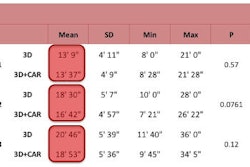Stroke care physicians are dismayed by an advisory organization's decision to reject a rule change calling for CT head scans to be performed within 45 minutes of a stroke patient's presenting to the hospital, according to an article that appeared Tuesday in the Wall Street Journal.
Once a radiologist has examined a head CT scan of the suspected stroke patient at admission, he or she can make an informed decision as to whether anticlot treatment with tissue plasminogen activator (tPA) or another drug is more likely to revascularize a patient with a clot successfully, sparing brain tissue -- or alternatively, whether such treatment could lead to a potentially fatal hemorrhage.
A new rule recommending the rapid scans on admission was proposed to the Washington, DC-based National Quality Forum (NQF), a quasi-governmental group that sets medical guidelines that Medicare uses to evaluate and reimburse U.S. hospitals. But the NQF said that the vague wording of the rule raised too many questions.
"No one is denying that a person with a stroke should have a CT scan," Dr. David Levin, chairman emeritus of radiology at Philadelphia's Thomas Jefferson University and co-chairman of the NQF's committee to evaluate the proposed rule, explained in the article. But the proposed rule was imprecisely written, so the stroke steering committee asked for more precise definitions of terms such as "acute stroke."
One problem is that some nonstroke patients arrive at a hospital with symptoms that resemble stroke, including numbness and weakness. What constitutes acute stroke was not defined, he said. The term "arrival" was also unclear and could refer to either the patient's arrival at the hospital door or the moment when the nurse's triage had begun, Levin explained.
But according to NQF correspondence obtained by AuntMinnie.com, a July 9 request to the developer for clarification of the terms "arrival" and "acute stroke," as well as elimination of the term "code stroke," has not yielded any reply.
"The measure developer has always been welcomed to make those [terminology] changes," NQF representative Rebecca Fleischauer told AuntMinnie.com. "But they have not updated the language," she said, neither in response to the memo nor "during a 30-day public comment period during which no negative comments [opposing the rule change] were received."
The lack of response is not inadvertent on the developer's part, Fleischauer added. "There has been a lot of communication [between the steering committee and the developer], and the co-chair of the stroke steering committee spoke to him as well."
But owing to the lack of response, the NQF believes it had no choice but to reject the proposed rule change, Fleischauer said, stating that the organization is hopeful that a new proposal will be reintroduced soon.
Yesterday, forum president and CEO Janet Corrigan, Ph.D., issued a statement on the organization's Web site confirming that the "measure developer is still encouraged to modify and resubmit the measure to NQF."
But stroke neurologists fear that the lack of a fast-scan rule, even a temporary one, will compromise stroke care across the U.S.
"If you don't image the person in a timely fashion, the whole treatment process is dead in the water. Every minute lost can translate into devastating consequences," Dr. David Liebeskind, associate director of neurology at the University of California, Los Angeles Stroke Center, told the Wall Street Journal.
Of course, the proposed changes amount to more than a new rule. Many facilities not specializing in stroke care lack around-the-clock staffing of a CT technologist and a radiologist to read the scans.
Studies indicate that only a small number of patients eligible for clot-busting tPA therapy receive it, either because the patient doesn't arrive on time or the hospital does not routinely provide the therapy, the Wall Street Journal noted.
The need for a fast-scan rule will be discussed in several committee meetings at the upcoming American Academy of Neurology (AAN) meeting in Seattle, April 25 to May 2, AAN's public relations manager Angela Babb told AuntMinnie.com.
Related Reading
DE-MRI may predict AF treatment outcomes, April 9, 2009
Tenecteplase up to 6 hours after acute ischemic stroke shows promise, March 31, 2009
Atrial fibrillation tied to cognitive impairment in patients without stroke, September 26, 2008
Copyright © 2009 AuntMinnie.com



















